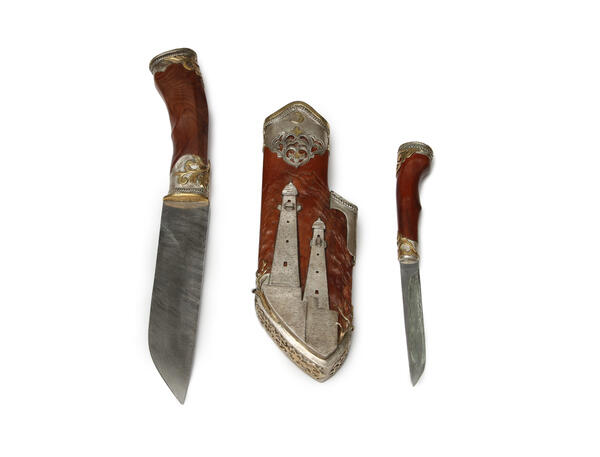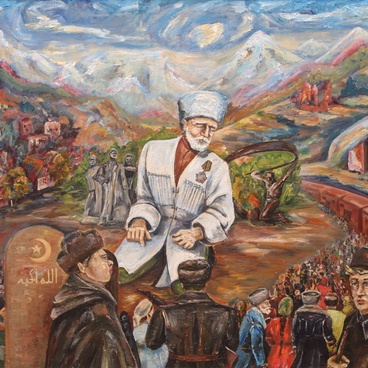‘Targim’ is the name of an ancient settlement in Ingushetia with a large tower complex. It was built around the 15th-17th centuries on the right bank of the Assa River. Targim is classified as a castle complex, which means that it was not only a military fortification for protecting the road and the surrounding settlements but also a place where big families lived.
Four combat towers and more than 20 semi-combat and residential towers with other buildings have been preserved here. The architecture of Targim is famous for its elegance: the proportions of the old towers were adjusted so that the width of the base of each of them is equal to one-tenth of the height.
Artist-gunsmith Vladislav Makhno made the ‘Targim Knife’ in 2012 at the request of the Museum of Fine Arts. He made two hunting knives for one type of scabbard: one is used for skinning and butchering prey, and a small penknife is designed for skinning smaller animals.
The master made the handles of the knives from valuable yew wood, and the blade was made of Damascus steel. Damascus steel is easily distinguished by the nonuniform pattern on the surface. Blacksmiths get this steel from different kinds of metal: that is why the surface does not have a uniform pattern. The main advantage of Damascus steel is the combination of hardness and flexibility, which is obtained due to the mixed materials.
Vladislav Makhno was born on October 24, 1936, in Grozny, the Checheno-Ingush Autonomous Soviet Socialist Republic. He joined the Artists’ Union of the USSR in 1990. The artist, in his 8th grade, made his first knife using an old file. Since then, making knives has become his lifelong passion.
Presently, the main materials for his artworks are valuable varieties of wood, lizard or ray skin, and precious metals.
Four combat towers and more than 20 semi-combat and residential towers with other buildings have been preserved here. The architecture of Targim is famous for its elegance: the proportions of the old towers were adjusted so that the width of the base of each of them is equal to one-tenth of the height.
Artist-gunsmith Vladislav Makhno made the ‘Targim Knife’ in 2012 at the request of the Museum of Fine Arts. He made two hunting knives for one type of scabbard: one is used for skinning and butchering prey, and a small penknife is designed for skinning smaller animals.
The master made the handles of the knives from valuable yew wood, and the blade was made of Damascus steel. Damascus steel is easily distinguished by the nonuniform pattern on the surface. Blacksmiths get this steel from different kinds of metal: that is why the surface does not have a uniform pattern. The main advantage of Damascus steel is the combination of hardness and flexibility, which is obtained due to the mixed materials.
Vladislav Makhno was born on October 24, 1936, in Grozny, the Checheno-Ingush Autonomous Soviet Socialist Republic. He joined the Artists’ Union of the USSR in 1990. The artist, in his 8th grade, made his first knife using an old file. Since then, making knives has become his lifelong passion.
Presently, the main materials for his artworks are valuable varieties of wood, lizard or ray skin, and precious metals.



